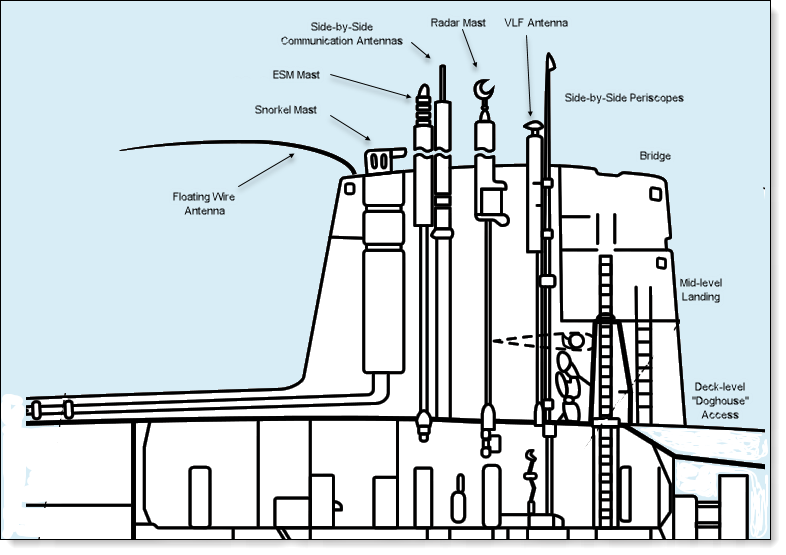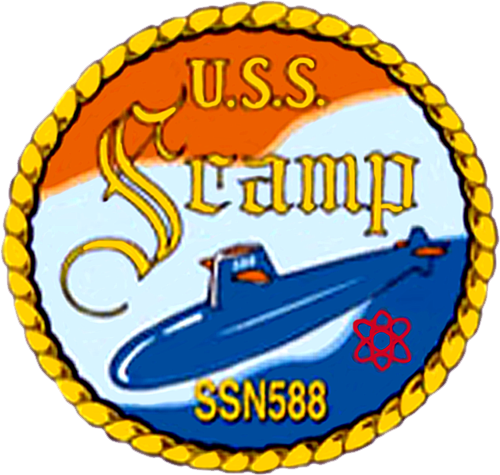
| Ship's Characteristics | |
|---|---|
| Class and type | Skipjack-class Nuclear Fast Attack Submarine |
| Displacement | 2,830 long tons (2,880 t) surfaced |
| 3,500 long tons (3,600 t) submerged | |
| Length | 251 ft 8 in (76.71 m) |
| Beam | 32 ft (9.8 m) |
| Draft (Surfaced) | 25 ft (7.62 m) |
| Speed | 31 knots (36 mph; 57 km/h) |
| Diving Depth | > 400 Feet (122 m) |
| Crew Complement | 8 officers & 85 enlisted |
| Propulsion | |
| 1 × S5W reactor | |
| 2 × Westinghouse steam turbines, 15,000 shp (11 MW) | |
| 1 shaft w/5-Blade Screw (Commissioning) w/7-Blade Screw (Retrofit) |
|
| Auxiliary Propulsion Motor (APM) | |
| Sonar Systems | |
| BQR-12 Active Sonar | |
| BQR-2 Passive Sonar | |
| BQS-4 (Modified) Active/Passive | |
| AN/WLR-9 Acoustic Intercept Active Sonar | |
| Towed Array (Hard Mount) | |
| AN/UQN-1 Fathometer | |
| Combat Electronic Systems | |
| Radar: AN/BPS-13 | |
| Electronic Warfare: AN/WLR-6 | |
| Fire Control: MK-101 Torpedo FCS | |
| IFF: MK-12 Transponder | |
| Electronic Navigation | |
| Magnavox 702 Satellite Navigation Set | |
| Omega VLF Radio Navigation Set | |
| LORAN A Radio Navigation Set | |
| Masts and Antennas | |
| No. 1 Periscope: Type 2F | |
| No. 2 Periscope: Type 15B | |
| AN/BPS-13 Radar Antenna | |
| AT-317BRR VLF Antenna | |
| AN/BRA-9 HF Antenna | |
| AN/BRA-19 Multifunction Antenna | |
| AN/BRD-6B RDF Antenna | |
| AN/BLA-4 ESM Mast | |
| Snorkel Mast | |
| OE-176 Floating Wire Antenna | |
| Armament | |
| 6 × 21 in (530 mm) torpedo tubes forward | |
| MK-16 Torpedo | |
| MK-37 Torpedo | |
| MK-48 Torpedo | |
| Forward and Aft Signal Flare Launchers | |

- Free-Flood Space with Upper and Lower hydrophones, Separated by Torpedo Tubes
- Anchor with Anchor handling Equipment Lower Space
- Bow Compartment
- Upper-Level: Crews Berthing (“Hanging Gardens”) and Supply Office
- Torpedo Room
- Ops Compartment
- Upper-Level: Control Room, Radio Room, Sonar Room, Yeoman’s Office
- Mid-Level: Crews Mess and Wardroom
- Lower-Level: Crew’s Berthing
- Battery and Auxiliary Trim Tanks
- Reactor Compartment
- Aux Machinery Space, Upper and Lower Levels
- Lower-Level: Emergency Diesel Generator
- Engine Room, Upper and Lower Levels
- Upper-Level: Maneuvering with Reactor Control Space

- Pressure Hull
- Outer Hull
The area between the pressure hull and outer hull was used for main ballast tanks and free-flood spaces. The free-flood spaces housed high-pressure air flasks and other equipment that could be exposed to sea pressure. The boat’s mushroom anchor and chain was housed in the forward free-flood area.

Close-up view of the Scamp’s Sail, with retractable masts and antennas. The two periscopes, radar mast, and ESM mast extended into the pressure hull. The Radio Direction Finder (RDF) antenna is hidden by the radar mast in this view. The “turtleback” (hump behind the sail) housed the exhaust piping from the emergency diesel located in the lower-level Aux Machinery Space.
The Skipjack-class subs were unique in that there were doors on each side of the Sail giving access to the Fairwater Planes. Main access into the boats were from a fold-up accommodation ladder stored inside the mid-level area of the sail. In-port this ladder was rigged to the end of either fairwater plane and extended to the pier. There was also a lower access door on the sail at deck level, called the “Doghouse,” with an interior ladder up to the mid-level truck access. This trunk and ladder were used to access the weather deck while underway. The forward and aft weather deck safety tracks both terminated at the Doghouse door.
